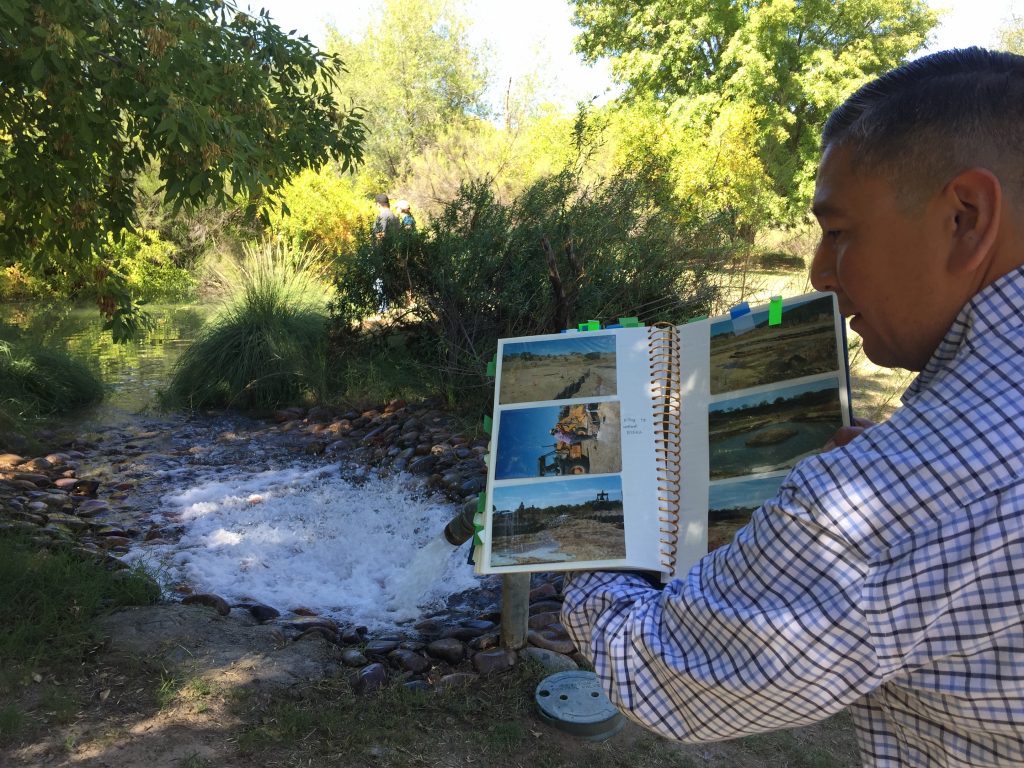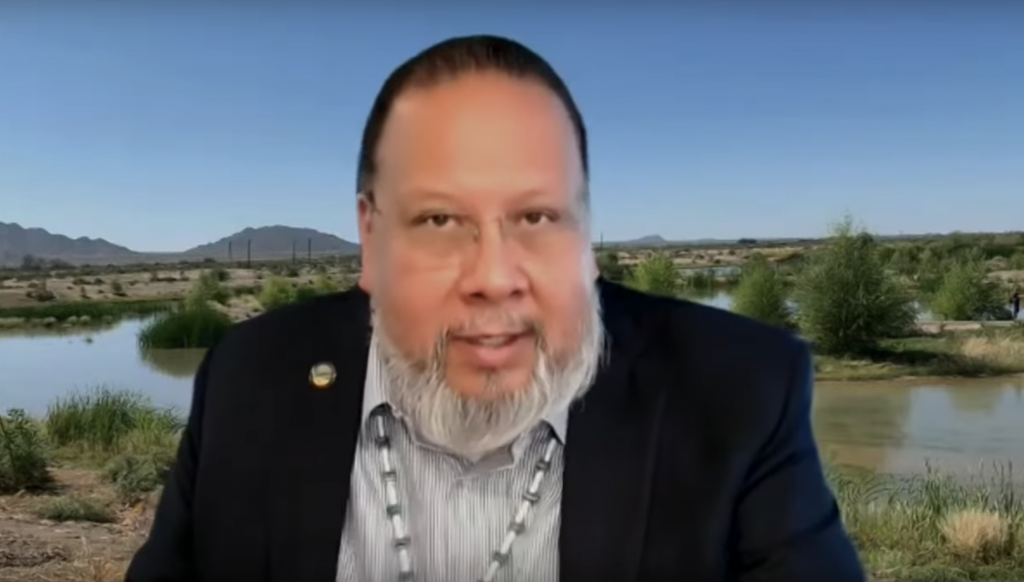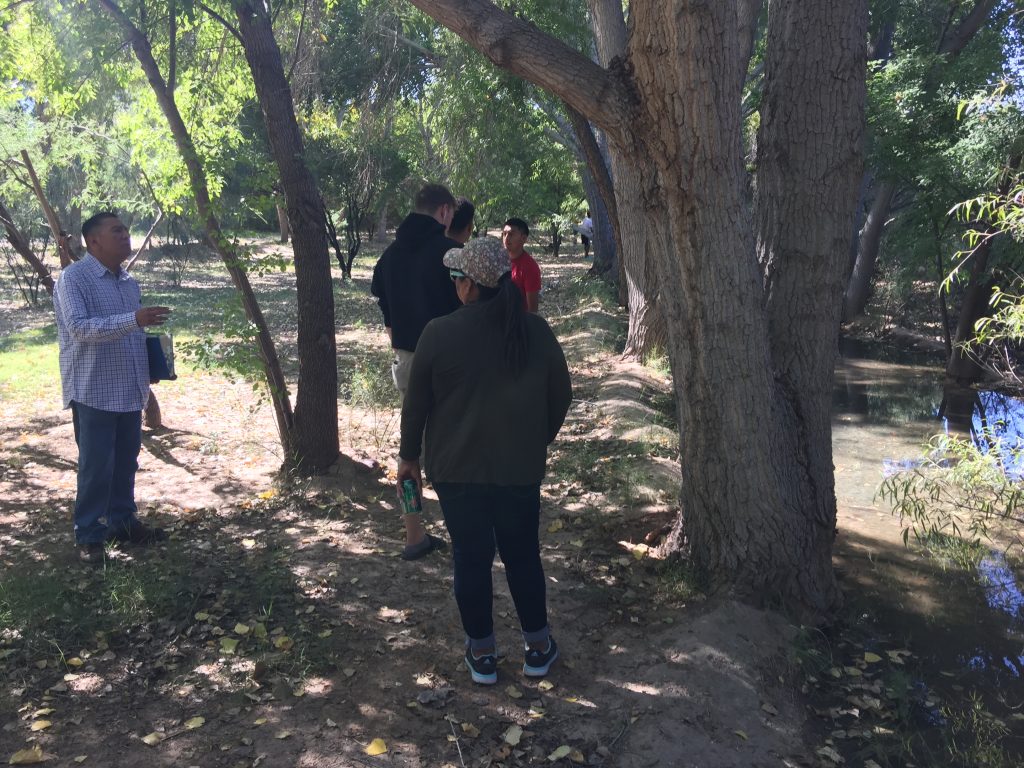As the desert southwest becomes hotter and drier, the Gila River Indian Community of Arizona is showing how it’s possible to both restore rivers and responsibly manage water used for agriculture and businesses.
By Melanie Lenart

At a 2015 conference on Indigenous Perspectives on Sustainable Water Practices, Gila River Indian Community Gov. Stephen Lewis talked about the tribe’s plans to bring its namesake river back to life using Colorado River water allocated in a settlement. Six years later, during the recent White House Tribal Summit, Lewis spoke about how the water deliveries that began in 2014 had restored flow in much of the Arizona tribe’s segment of the Gila River.
“The land is healing itself. All of our traditional plants are blooming now,” Lewis said during the summit. “This has helped in revitalizing our traditional culture and arts. Our elders are now using the site to harvest our traditional plants for our famous baskets for our traditional ceremonies.”
Lewis was one of three tribal leaders featured along with federal appointees during a discussion on how traditional ecological knowledge and values can help address climate change. Along with bringing more intense rainfall around the world, the warming climate is increasing drought risk—in part because higher temperatures evaporate water more quickly.
During the summit, Lewis officially announced a new project that will help protect the incoming water from rising evaporation rates: the construction of a solar-panel array over a segment of the tribe’s irrigation canals.
“This project will not only generate solar power using the land already dedicated to our canals. It will also save precious water from evaporation from those canals, an essential new way of helping to create durable long-term new water supplies in a very arid region,” Lewis said. “While solar-covered canals have often been spoken of in the United States, this is the first one that is actually going to be built.”

Saving water while making electricity
Lewis credited the Biden administration for providing funding to help the tribe pay for the renewable energy pilot project for solar-covered-canals, which so far have only been carried out in India. The project in Arizona is expected to be completed in 2022.
“This is very in line and supports our values as caretakers and protectors of our shuhthagi, our waters,” as Lewis said during the summit. “And it would not have been possible without the strong support of this administration, again, allowing us to lead, to bring solutions to be models of what we can do as indigenous people in addressing climate change and trusting us to develop, as tribal nations, real solutions to our common problems.”
In mid-December, Lewis was busy attending a conference of the Colorado River Users Association, but David DeJong, was able to provide more details on the planned project. DeJong directs the Pima-Maricopa Irrigation Project, or PMIP, a federally funded project tasked with helping to deliver water to the Gila River Indian Community.
“Earlier this year, Gov. Lewis called me,” DeJong said by phone. “He said, ‘Hey, I would like PMIP to look into this idea of doing solar-over-canals with the idea of creating an entirely new paradigm for irrigation canal construction and operation in the western United States.'”
The governor selected a site near where the 2015 conference was held, at the tribe’s Wild Horse Pass Hotel and Casino, DeJong said. This way, the project will be visible to those driving along the I-10 highway as well as those visiting the casino or the nearby Phoenix Premium Outlets.
“We call it a pilot project, but we think it’s going to be very successful,” DeJong said. He and his team plan to cover about 1,000 feet of the canal with solar panels, which will be hinged so they can be lifted when cleaning out silt and otherwise maintaining the concrete-lined irrigation canal below. They project the panels will generate about 750 kilowatt-hours of power, worth about $50,000 in the current market.
Less evaporation, more electricity
Generating power could actually offer a way to support the water transfers. That’s because tribes with rights to the Colorado River water still face the challenge of contributing to the energy cost of moving the water uphill through much of the basin. The fund designated for this purpose has been running low as electricity prices have risen, leaving tribes scrambling to pay for the “free” water that is supposed to replenish their aquifers and support residences and businesses, including farms.
Although administrators are still working out the cost and the details about how much the Gila River Indian Community will need to commit alongside federal funding for the solar-over-canals project, DeJong said the hope is that the 1,000-foot-long pilot project will eventually cover as many miles of the canals as it takes to provide the energy needed for the sophisticated water irrigation system.
They will be eyeing another 160 miles of concrete-lined irrigation canals for the larger project, keeping in mind issues such as proximity to power distribution stations and ease of maintenance.
“There’s a feral horse population, for instance, and a lot of feral dogs. There are cattle ranchers and the reservation land is open range. Every year, there are animals that get into the canal,” DeJong said. “The point of all that is those are all issues we have to take into consideration as we look at putting solar over the canal.”
Even as the panels will shield the water from evaporation, the water will help keep the panels cooler than they would be if they were sitting elsewhere in the desert. This, in turn, improves the efficiency of the solar panels because energy production declines under hotter conditions. Based on estimates from a test site of the contractor, Tectonicus, that are still being refined, evaporation rates should drop by half or more—potentially up to 90 percent—while the efficiency of solar panels should improve by 3 to 10 percent.
Researchers associated with the University of California estimated in March that covering all 4,000 miles of their state’s irrigation canals would reduce evaporation to the tune of 65 billion gallons of water a year. Taking that and the cost savings from increased solar panel efficiency, as well as other benefits, such as not having to purchase land for new solar projects, the research team concluded the solar-over-canal approach would actually save money as well as water in the long run.

Conserving the Colorado
Interest in conserving Colorado River water has grown as the reservoirs have shrunk during the past two decades of drought in the West.
The low levels of the two main reservoirs, Lake Mead and Lake Powell, have raised concerns about having to reduce supplies to the seven states that tap into the Colorado River. So far, that discussion has been pushed off—thanks in part to non-use of water by the tribes with rights to it. For instance, Lewis said in November that the Gila River Indian Community left 500,000 acre-feet—the equivalent of 163 million gallons—of water unused since 2016. That’s enough to raise Lake Mead by 8 feet.
“By rejuvenating our aquifer, we are now able to rely on pumping groundwater supplies for our needs on our community, which in turn allows us to leave much of our Colorado River entitlement in Lake Mead in the times of shortage that we’re experiencing now,” Lewis said.
Colorado River water arriving through the Central Arizona Project canal system represents the about half of the 653,500 acre-feet allocated to the tribe, DeJong said. Other water sources now include the Salt River and, yes, the Gila River where it still flows upstream. The tribe also has a 99-year lease to provide 15,000 acre-feet of its allocation annually to Phoenix, DeJong indicated, in return for about $27 million.
As of 2015, Native Americans held 20 percent of the Colorado Basin’s water rights, according to a Circle of Blue article. Meanwhile, 13 of the 29 tribes with rights to the Colorado have claims to water that have not yet been settled. This includes the Navajo Nation, where about 180,000 of the tribe’s members live.
Returning stolen water
In a 2009 book called Stealing the Gila, DeJong recounts how the Gila River Indian Community, known to themselves as the Akimel O’odham and to early European immigrants as the Pima Indians, had a thriving economy using irrigation to sustain their farms. For several decades in the mid-1800s, they grew enough food to feed themselves as well as many immigrants, including those coming to mining towns such as Prescott and from Tucson down through Tubac.
As more immigrants moved in upstream, though, the resulting water diversions left tribal farmers in the dust. Some of the Akimel O’odham shifted to the lower-quality food provided by the government, but hundreds of elders who were unwilling to accept handouts starved in their homes, DeJong reported.
Finally, a 1908 U.S Supreme Court ruling known as the Winters decision decreed that the creation of Indian reservations came with an implied right to water, putting indigenous peoples ahead of miners and other immigrants for this precious resource. Yet the decision did little to break the imposed cycle of poverty because the law was poorly enforced. The Gila River remained a dry bed, left barren by upstream water diversions and groundwater pumping from wells, unable to sustain the agriculture that had defined the Akimel O’odham for at least a thousand years.

DeJong, who holds a doctorate in American Indian policy studies, more recently released Diverting the Gila, the second in a planned five-book University of Arizona Press series about the river and the people depending on it.
“The idea of river restoration goes back to early 20th century, after Coolidge Dam and all the upstream diversions pretty much killed off the flora and fauna along the river,” DeJong said. “The community never lost sight of wanting to restore the river. I mean, they are the Akimel O’odham, right? The River People.”
The Akimel O’odham are considered a sister tribe to the Tohono O’odham—the Desert People. The Tohono O’odham were among the first tribes to win a settlement for the return of some water, with water deliveries starting around 2004. Among other things, the Tohono O’odham use their allocated 66,000 acre-feet to support an organic farm, the San Xavier Cooperative Farm, and to restore its own riparian area near the San Xavier del Bac Mission in Tucson. The native vegetation had mostly died off as Tucson’s growing population sucked up water, but piping in Colorado River water allowed cottonwood and sycamore trees to reach heights of 60 feet in less than two decades.
Both O’odham riparian areas feature native cottonwood and willow trees, as well as a variety of other native vegetation and wildlife. Some 40 or 50 bird species have returned to the Gila River restoration sites, and DeJong said he expects to see beavers along the river at some point. Beavers build dams that slow water, activities that tend to improve flow as well as groundwater recharge.
Elders from the Gila River Indian Community guided the selection of plants as well as benches and other amenities along a mile-long interpretive nature trail. One of the Akimel O’odham artisans involved in the river restoration project put in a call to DeJong while he was conversing with Native Science Report. Until recently, she had to seek out the plants needed for her basket-making in other areas, such as around the Salt River.
“Now she goes to that (restored) site and she harvests the material she needs for making baskets,” he said. “She can do it all within her own community. That’s what it’s about—restoring the cultural, the economic, the spiritual values.”
As Lewis put it during the 2015 conference on Indigenous Perspectives of on Sustainable Water Practices, “Our story is one of welcoming back our most precious resource of water. The story is about healing our community. And ultimately, the story is about building a new beginning.”
• • •
Melanie Lenart is a regular contributor to Native Science Report. She previously taught at Tohono O’odham Community College, including a course in Water Resources.
Story published December 19, 2021
• • •
Enjoyed this story? Enter your email to receive notifications.
